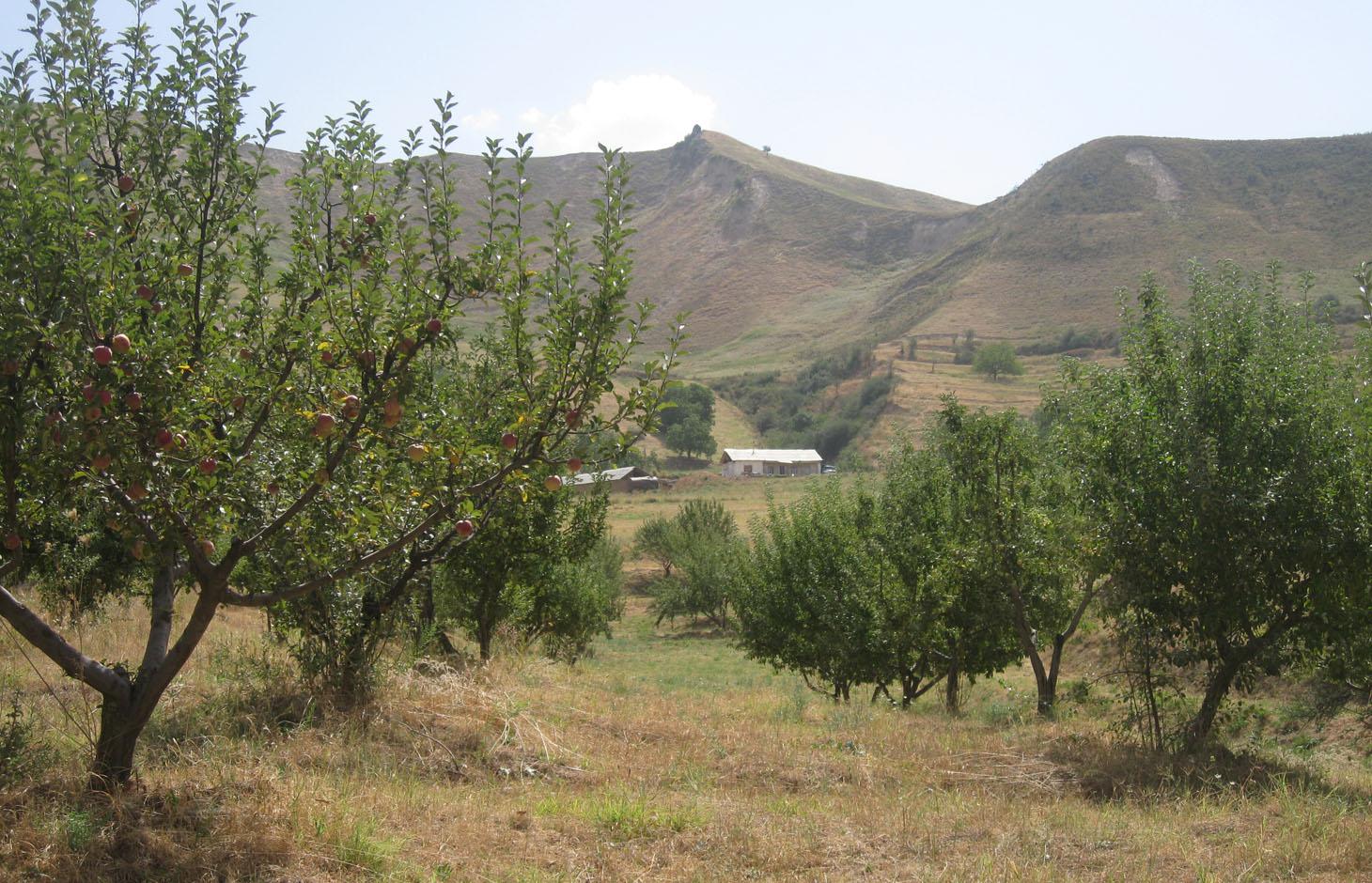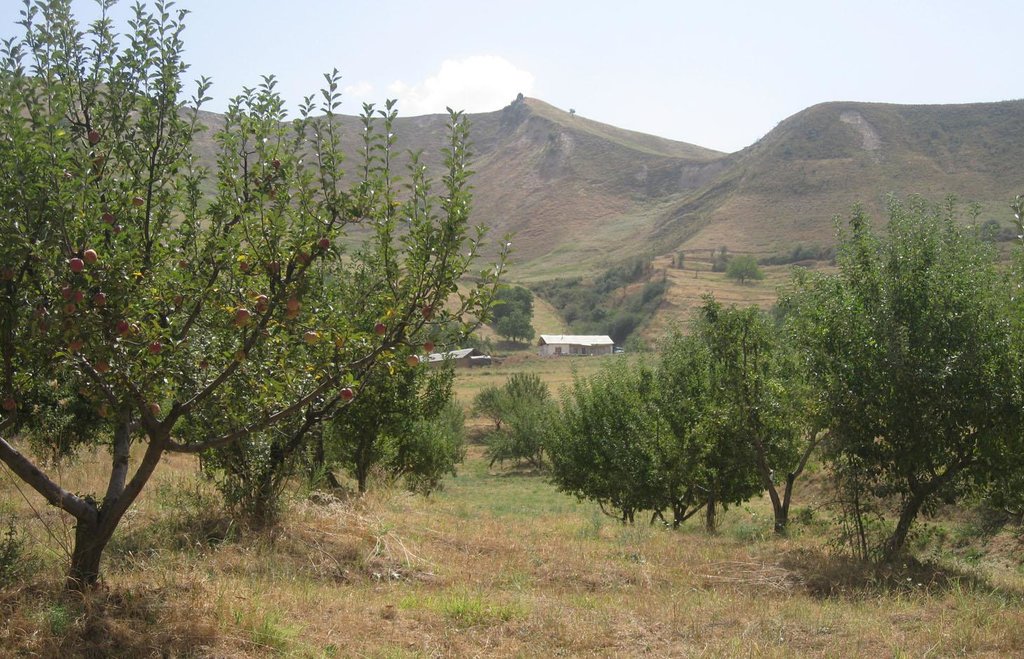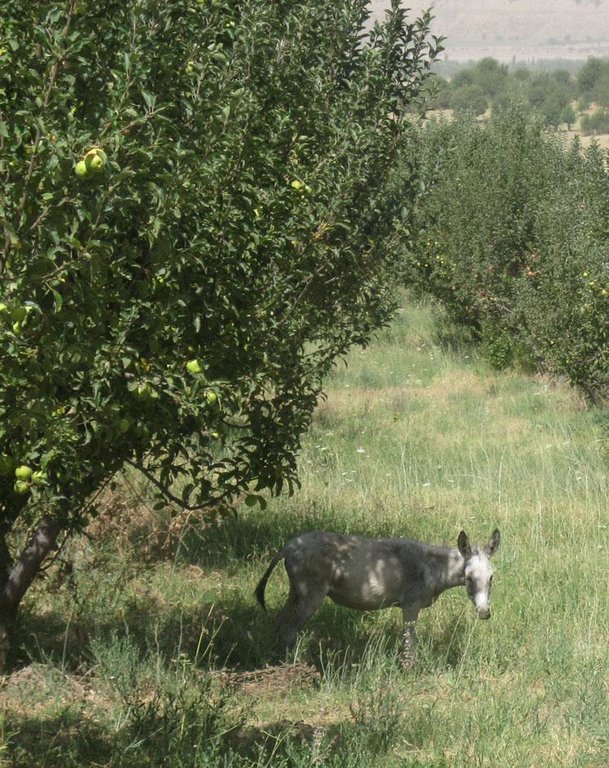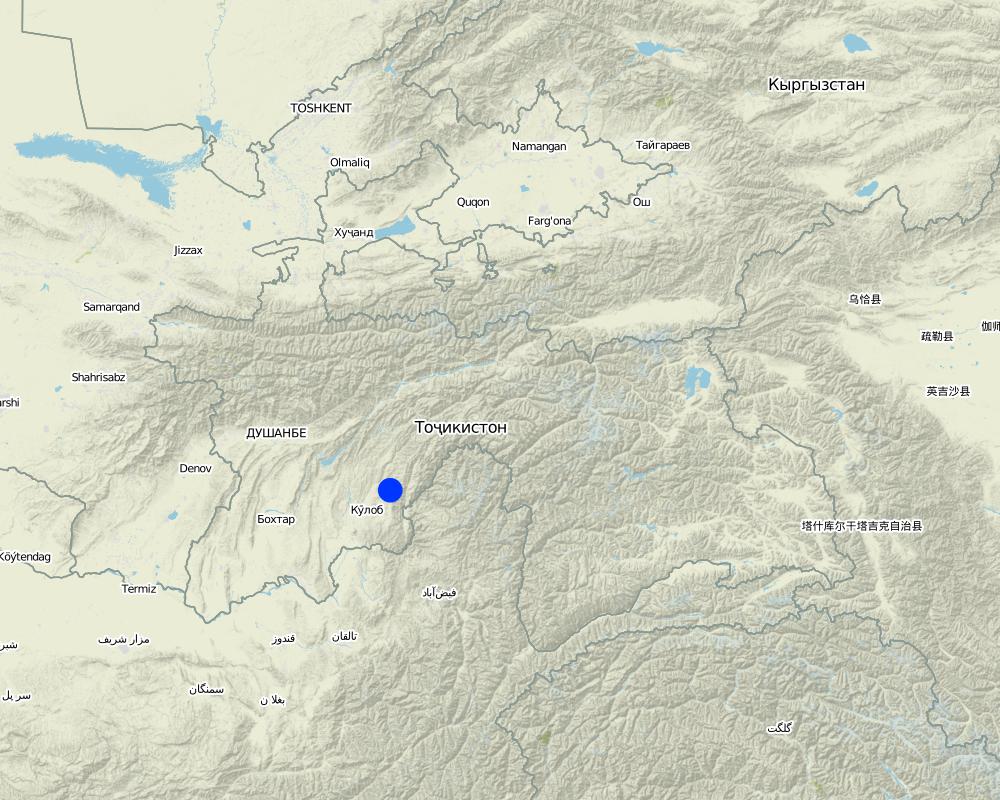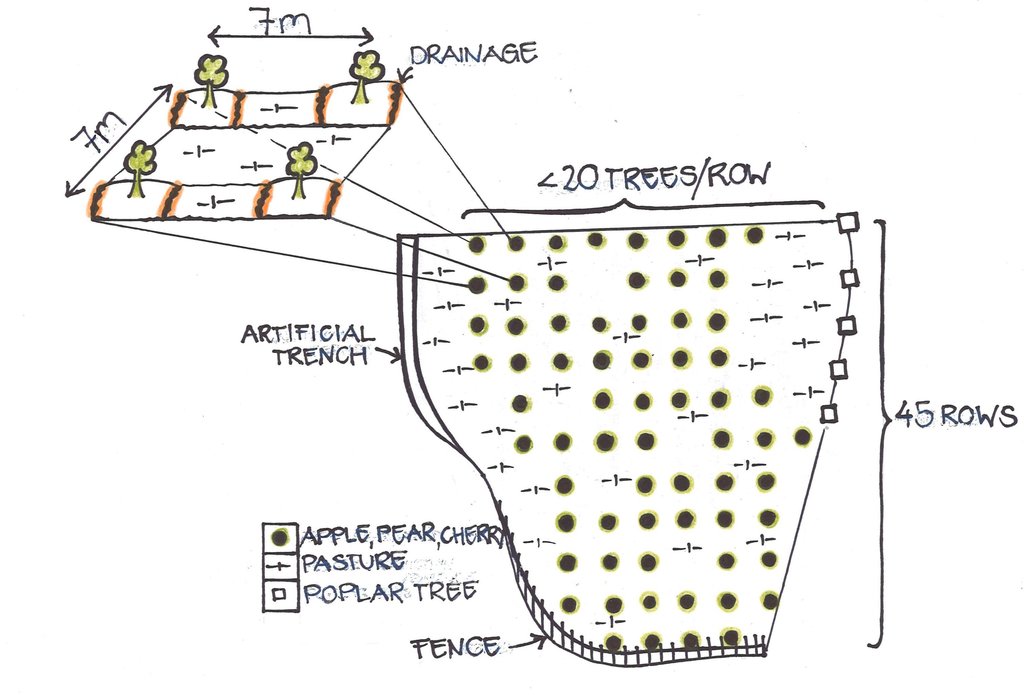Silvo-pastoralism: Orchard with integrated grazing and fodder production [Tadjikistan]
- Création :
- Mise à jour :
- Compilateur : Malgorzata Conder
- Rédacteur : –
- Examinateurs : Deborah Niggli, Alexandra Gavilano
technologies_1554 - Tadjikistan
Voir les sections
Développer tout Réduire tout1. Informations générales
1.2 Coordonnées des personnes-ressources et des institutions impliquées dans l'évaluation et la documentation de la Technologie
Spécialiste GDT:
Nom du ou des institutions qui ont facilité la documentation/ l'évaluation de la Technologie (si pertinent)
NCCR North-South (NCCR North-South) - Kirghizistan1.3 Conditions relatives à l'utilisation par WOCAT des données documentées
Le compilateur et la(les) personne(s) ressource(s) acceptent les conditions relatives à l'utilisation par WOCAT des données documentées:
Oui
1.4 Déclaration sur la durabilité de la Technologie décrite
Est-ce que la Technologie décrite ici pose problème par rapport à la dégradation des terres, de telle sorte qu'elle ne peut pas être déclarée comme étant une technologie de gestion durable des terres?
Non
2. Description de la Technologie de GDT
2.1 Courte description de la Technologie
Définition de la Technologie:
Increased productivity of the land by planting fruit trees and conserving the land by restricting the access of livestock resulting in improved runoff retention
2.2 Description détaillée de la Technologie
Description:
In Soviet times, this area of totally 40 ha comprised terraces and walnut trees in the steep foothills and pastures in the lower and flatter part. After the collapse of the Soviet Era, many similar areas got degraded due to uncontrolled grazing and overuse of natural resources. The area described in this documentation, in contrast, was taken over by a family in 1991. Within the whole area of 40 ha, roads were built to improve the access and 6000 trees were planted, whereof 1200 fruit trees were planted on the pasture, conversing it into an orchard.
At present, the 6 ha of orchard are mainly consisting of three types of apple (white, golden and red), some pear and cherry trees. Several trees must have dried out or have been cut, as the farmer counts currently around 1000 fruit trees. The whole orchard is combined with pasture land. The farmer let his livestock graze in the orchard, and cuts the remaining grass in autumn, if there is still left.
The integrated orchard with pastureland and fodder production is partially fenced to hinder livestock entering his property. Furthermore, the orchard is within the range of vision which allows the farmer`s family to guard it.
The farmer who is managing the orchard today obtained the property of his father in order to continue the family project by his own initiative. By farming he ensures the livelihood of his family. Hence, he felt responsible to progress and improve the quality of life of his own family. The main reason for establishing the orchard within the grassland and to install fences, was to increase productivity of the land, bringin along beneficial effects on soil quality. According to his land users certificate, the main purpose of this land is to provide the local market with food products.
After planting, some of the seedlings were stolen or eaten by livestock from neighbouring farms. Initial labour input in the newly established orchard consisted of getting and planting the seedlings and applying pesticides. The trees are being maintained by pruning. Soil is loosened and drainage provided to increase water infiltration and to protect the trees additionally from parasites. The pasture is grazed by the livestock of the farmer. As the family only has a small number of livestock, grass is cut afterwards and used as fodder. Half of the fodder harvest belongs to the hired worker, the other half belongs to the farmer. The other tasks are executed by the farmer and his family.
The climate is semi-arid with precipitation (800mm totally) mainly during winter and spring time. Altitude is around 1380 m asl. The plot is located at the foothill, with the wider riverbed and fan downstream and overgrazed hills upstream. Bordering with the property from above, a steep slope with a dense vegetation of grafted fruit trees and walnut trees stabilizes the soil.The farmer is living with the family on the property, near the village of Momandion. In the past many livestock from nearby entered the property and grazed there. Through better control and fences less livestock is entering. The property is located directly on the road to Muminabad, the center of the District with a market- 2 km away.Considering the establishment costs of the orchard, the farmer is a fairly whealthy man, nevertheless he had to rely on his family and friends in terms of the working input.The establishment phase was a time and money consuming
2.3 Photos de la Technologie
2.5 Pays/ région/ lieux où la Technologie a été appliquée et qui sont couverts par cette évaluation
Pays:
Tadjikistan
Région/ Etat/ Province:
Khatlon, Tajikistan
Autres spécifications du lieu:
Muminabad
Spécifiez la diffusion de la Technologie:
- répartie uniformément sur une zone
S'il n'existe pas d'informations exactes sur la superficie, indiquez les limites approximatives de la zone couverte:
- < 0,1 km2 (10 ha)
Commentaires:
Total area covered by the SLM Technology is 0.06 km2.
Orchard is within the farmer's land property of totally 40 ha
Map
×2.6 Date de mise en œuvre de la Technologie
Si l'année précise est inconnue, indiquez la date approximative: :
- il y a entre 10-50 ans
2.7 Introduction de la Technologie
Spécifiez comment la Technologie a été introduite: :
- grâce à l'innovation d'exploitants des terres
Commentaires (type de projet, etc.) :
22 years ago
3. Classification de la Technologie de GDT
3.1 Principal(aux) objectif(s) de la Technologie
- améliorer la production
- réduire, prévenir, restaurer les terres dégradées
3.2 Type(s) actuel(s) d'utilisation des terres, là où la Technologie est appliquée

Terres cultivées
- Plantations d’arbres ou de buissons
Plantations d'arbres et d'arbustes - Précisez les cultures:
- fruits à pépins (pommes, poires, coings, etc.)
- fruits à noyaux (pêche, abricot, cerise, prune)

Pâturages
Pâturage extensif:
- Pastoralisme de type semi-nomade
Commentaires:
Livestock density (if relevant):
50-100 LU /km2
Major land use problems (compiler’s opinion): No major problems because of the early implementation of the technology which prevented the area of being (over)grazed without control
Major land use problems (land users’ perception): The farmer is afraid of a possible landslide on his property. Another issue is the lack of a continuous fence, because still some unwanted livestock is able to enter the orchard. He installed a water point next to his house recently.
Other grazingland: agropastoralism: first grazing and if grass is left, then cut
3.3 Est-ce que l’utilisation des terres a changé en raison de la mise en œuvre de la Technologie ?

Pâturages
Pâturage extensif:
- Pastoralisme de type semi-nomade
Commentaires:
Grazing land: Extensive grazing land
3.4 Approvisionnement en eau
Approvisionnement en eau des terres sur lesquelles est appliquée la Technologie:
- pluvial
3.5 Groupe de GDT auquel appartient la Technologie
- agroforesterie
- pastoralisme et gestion des pâturages
3.6 Mesures de GDT constituant la Technologie

pratiques végétales
- V1: Couverture d’arbres et d’arbustes

modes de gestion
- M1: Changement du type d’utilisation des terres
- M2: Changement du niveau de gestion / d'intensification
Commentaires:
Type of vegetative measures: aligned: -contour
3.7 Principaux types de dégradation des terres traités par la Technologie

érosion hydrique des sols
- Wt: perte de la couche superficielle des sols (couche arable)/ érosion de surface
- Wo: effets hors-site de la dégradation

dégradation physique des sols
- Pc: compaction

dégradation biologique
- Bc: réduction de la couverture végétale
Commentaires:
Main causes of degradation: overgrazing (uncontrolled)
Secondary causes of degradation: population pressure (increased livestock), governance / institutional (no or undeveloped pasture management after Soviet collapse)
3.8 Prévention, réduction de la dégradation ou réhabilitation des terres dégradées
Spécifiez l'objectif de la Technologie au regard de la dégradation des terres:
- prévenir la dégradation des terres
- réduire la dégradation des terres
4. Spécifications techniques, activités, intrants et coûts de mise en œuvre
4.1 Dessin technique de la Technologie
Spécifications techniques (associées au dessin technique):
The orchard is situated within the farmers' property which is almost completely fenced by an artificial trench, thornbush fences, poplar trees and a natural steep slope. The orchard is 6 ha in size and consists of around 45 rows, with some 20 trees per row on average. In some places trees are missing due to drying out or cutting. Currently approximately 1000 fruit trees are growing. In between the tree rows and at the borders of the orchard, grass is growing and grazed by animals, and if not entirely grazed cut for haymaking in autumn.
The fruit trees grow at a distance of 7 meters. Around the trees the soil is loosened and a tiny trench is dug, the latter serving as a rainwater drainage.
Location: Momandion. Muminabad, Khatlon, Tajikistan
Date: 14.09.2012
Technical knowledge required for land users: moderate (Good knowledge for planting required, knowledge about maintenance activities is probably more widespread amongst farmers, idea of fencing is lacking)
Main technical functions: control of concentrated runoff: retain / trap, control of concentrated runoff: impede / retard, control of concentrated runoff: drain / divert, improvement of ground cover, improvement of topsoil structure (compaction), spatial arrangement and diversification of land use
Secondary technical functions: control of raindrop splash, control of dispersed runoff: retain / trap, control of dispersed runoff: impede / retard, stabilisation of soil (eg by tree roots against land slides), increase in organic matter, increase in nutrient availability (supply, recycling,…), increase / maintain water stored in soil, increase of groundwater level / recharge of groundwater, increase of biomass (quantity), promotion of vegetation species and varieties (quality, eg palatable fodder), reduction of dry material (fuel for wildfires)
Aligned: -contour
Number of plants per (ha): 200
Vertical interval between rows / strips / blocks (m): 7
Spacing between rows / strips / blocks (m): 7
Vertical interval within rows / strips / blocks (m): 7
Width within rows / strips / blocks (m): 7
Fruit trees / shrubs species: Apple, pear, cherry
Change of land use type: change of pasture land into an orchard with integrated pasture land and fodder production (Silvopastoralism)
Change of land use practices / intensity level: Fencing hence more extensive and controlled grazing
Auteur:
Conder Malgorzata
4.2 Informations générales sur le calcul des intrants et des coûts
autre/ monnaie nationale (précisez):
Somoni
Indiquez le taux de change des USD en devise locale, le cas échéant (p.ex. 1 USD = 79.9 réal brésilien): 1 USD = :
4,83
Indiquez le coût salarial moyen de la main d'œuvre par jour:
12.40
4.3 Activités de mise en place/ d'établissement
| Activité | Calendrier des activités (saisonnier) | |
|---|---|---|
| 1. | Buying and transport of fruit seedlings (totally 6000 seedling, whereof 1200 seedlings on for the orchard of 6 ha) | once |
| 2. | Planting fruit tree seedlings (totally 6000 seedlings, whereof 1200 seedlings for the orchard), cost according to planted trees (3 TJS per tree) | once |
| 3. | Partial fencing (of around 200m) along the property, 10.5 days, 3-4 persons | 1991 |
| 4. | Building roads for access to the house | 1991 |
4.4 Coûts et intrants nécessaires à la mise en place
| Spécifiez les intrants | Unité | Quantité | Coûts par unité | Coût total par intrant | % du coût supporté par les exploitants des terres | |
|---|---|---|---|---|---|---|
| Main d'œuvre | labour | ha | 1,0 | 194,9 | 194,9 | 100,0 |
| Equipements | machine use | ha | 1,0 | 0,7 | 0,7 | 100,0 |
| Matériel végétal | seedlings | ha | 1,0 | 207,0 | 207,0 | 100,0 |
| Matériaux de construction | fence | ha | 1,0 | 124,2 | 124,2 | 100,0 |
| Coût total de mise en place de la Technologie | 526,8 | |||||
| Coût total de mise en place de la Technologie en dollars américains (USD) | 109,07 | |||||
Commentaires:
Duration of establishment phase: 1 month(s)
4.5 Activités d'entretien/ récurrentes
| Activité | Calendrier/ fréquence | |
|---|---|---|
| 1. | Pruning of 400 trees, ca. 40 days, 1 person, 3 TJS per tree (all trees pruned every 3 years) | spring/ once a year |
| 2. | Soil loosening around 1000 fruit trees, ca. 25 days (5 h/day), 1 person | spring/ once a year |
| 3. | Pesticides spraying once (should be done 2-3 times), 4 days (ca.5 h/d), 1 person | End of May/ once a year |
| 4. | After several years: Harvesting fruits (mainly apples) | September/every year |
| 5. | Cutting grass, by 10 people, one month, hours per day unknown. Half of straw harvest for owner, other half for the mowers as salary (4-5 Somoni/bundle). Total salary: 1000 bandles | End of summer |
| 6. | Guarding the orchard | all the time |
4.6 Coûts et intrants nécessaires aux activités d'entretien/ récurrentes (par an)
| Spécifiez les intrants | Unité | Quantité | Coûts par unité | Coût total par intrant | % du coût supporté par les exploitants des terres | |
|---|---|---|---|---|---|---|
| Main d'œuvre | labour | ha | 1,0 | 383,3 | 383,3 | 100,0 |
| Engrais et biocides | pesticides | ha | 1,0 | 7,8 | 7,8 | 100,0 |
| Coût total d'entretien de la Technologie | 391,1 | |||||
| Coût total d'entretien de la Technologie en dollars américains (USD) | 80,97 | |||||
Commentaires:
The structural fencing is adapted from T_TAJ047. Working hours are approximate as the work was done a long time ago, with the help of many relatives with different work times. No overview over the exact work and cost input exists, tools were mainly borrowed, prices unknown. Road building done in the past was not included, because current costs were difficult to estimate. Work as guardening is not monetarised. Apple harvesting as recurrent activity (vegetative measure) is derived from T_TAJ013. In the cost summary, the fencing was calculated proportionally to one ha.
4.7 Facteurs les plus importants affectant les coûts
Décrivez les facteurs les plus importants affectant les coûts :
Apart from the orchard, the whole property was rebuilt with roads, fences and tree planting which caused high initial costs during the establishment phase.
5. Environnement naturel et humain
5.1 Climat
Précipitations annuelles
- < 250 mm
- 251-500 mm
- 501-750 mm
- 751-1000 mm
- 1001-1500 mm
- 1501-2000 mm
- 2001-3000 mm
- 3001-4000 mm
- > 4000 mm
Spécifications/ commentaires sur les précipitations:
Totally 800 mm: 700mm in winter-spring, July-Sept dry season (At 1200m asl, weather station Muminabad)
Zone agro-climatique
- subhumide
Thermal climate class: temperate
5.2 Topographie
Pentes moyennes:
- plat (0-2 %)
- faible (3-5%)
- modéré (6-10%)
- onduleux (11-15%)
- vallonné (16-30%)
- raide (31-60%)
- très raide (>60%)
Reliefs:
- plateaux/ plaines
- crêtes
- flancs/ pentes de montagne
- flancs/ pentes de colline
- piémonts/ glacis (bas de pente)
- fonds de vallée/bas-fonds
Zones altitudinales:
- 0-100 m
- 101-500 m
- 501-1000 m
- 1001-1500 m
- 1501-2000 m
- 2001-2500 m
- 2501-3000 m
- 3001-4000 m
- > 4000 m
5.3 Sols
Profondeur moyenne du sol:
- très superficiel (0-20 cm)
- superficiel (21-50 cm)
- modérément profond (51-80 cm)
- profond (81-120 cm)
- très profond (>120 cm)
Texture du sol (de la couche arable):
- moyen (limoneux)
- fin/ lourd (argile)
Matière organique de la couche arable:
- moyen (1-3%)
5.4 Disponibilité et qualité de l'eau
Profondeur estimée de l’eau dans le sol:
< 5 m
Disponibilité de l’eau de surface:
faible/ absente
Qualité de l’eau (non traitée):
eau potable
5.5 Biodiversité
Diversité des espèces:
- moyenne
5.6 Caractéristiques des exploitants des terres appliquant la Technologie
Revenus hors exploitation:
- moins de 10% de tous les revenus
Niveau relatif de richesse:
- riche
Individus ou groupes:
- individu/ ménage
Genre:
- hommes
Indiquez toute autre caractéristique pertinente des exploitants des terres:
Land users applying the Technology are mainly common / average land users
Population density: 100-200 persons/km2
Annual population growth: 1% - 2%
5.7 Superficie moyenne des terres utilisées par les exploitants des terres appliquant la Technologie
- < 0,5 ha
- 0,5-1 ha
- 1-2 ha
- 2-5 ha
- 5-15 ha
- 15-50 ha
- 50-100 ha
- 100-500 ha
- 500-1 000 ha
- 1 000-10 000 ha
- > 10 000 ha
Cette superficie est-elle considérée comme de petite, moyenne ou grande dimension (en se référant au contexte local)?
- moyenne dimension
5.8 Propriété foncière, droits d’utilisation des terres et de l'eau
Propriété foncière:
- état
Droits d’utilisation des terres:
- loué
Droits d’utilisation de l’eau:
- communautaire (organisé)
- individuel
Commentaires:
Land ownership is based on the land user certificate conferred by the government.
5.9 Accès aux services et aux infrastructures
santé:
- pauvre
- modéré
- bonne
éducation:
- pauvre
- modéré
- bonne
assistance technique:
- pauvre
- modéré
- bonne
emploi (par ex. hors exploitation):
- pauvre
- modéré
- bonne
marchés:
- pauvre
- modéré
- bonne
énergie:
- pauvre
- modéré
- bonne
routes et transports:
- pauvre
- modéré
- bonne
eau potable et assainissement:
- pauvre
- modéré
- bonne
services financiers:
- pauvre
- modéré
- bonne
6. Impacts et conclusions
6.1 Impacts sur site que la Technologie a montrés
Impacts socio-économiques
Production
production agricole
production fourragère
qualité des fourrages
production animale
Commentaires/ spécifiez:
As the area of the orchard with pasture is fenced it is not an communal pasture anymore as it was before
production de bois
Commentaires/ spécifiez:
From pruning
diversité des produits
surface de production
Disponibilité et qualité de l'eau
demande pour l'eau d'irrigation
Revenus et coûts
dépenses pour les intrants agricoles
revenus agricoles
diversité des sources de revenus
Impacts socioculturels
sécurité alimentaire/ autosuffisance
situation sanitaire
apaisement des conflits
contribution to human well-being
Commentaires/ spécifiez:
Products for market leading to higher income, sharing of some knowledge about management of private land enhances dissemination and exchange of information/knowledge.
Impacts écologiques
Cycle de l'eau/ ruissellement
ruissellement de surface
Sols
humidité du sol
couverture du sol
perte en sol
encroûtement/ battance du sol
compaction du sol
cycle/ recharge des éléments nutritifs
matière organique du sol/ au dessous du sol C
Biodiversité: végétale, animale
biomasse/ au dessus du sol C
contrôle des animaux nuisibles/ maladies
Réduction des risques de catastrophe et des risques climatiques
risques d'incendies
6.2 Impacts hors site que la Technologie a montrés
inondations en aval
capacité tampon/de filtration
dommages sur les champs voisins
6.3 Exposition et sensibilité de la Technologie aux changements progressifs et aux évènements extrêmes/catastrophes liés au climat (telles que perçues par les exploitants des terres)
Changements climatiques progressifs
Changements climatiques progressifs
| Saison | Augmentation ou diminution | Comment la Technologie fait-elle face à cela? | |
|---|---|---|---|
| températures annuelles | augmente | pas bien |
Extrêmes climatiques (catastrophes)
Catastrophes météorologiques
| Comment la Technologie fait-elle face à cela? | |
|---|---|
| pluie torrentielle locale | bien |
| tempête de vent locale | bien |
Catastrophes climatiques
| Comment la Technologie fait-elle face à cela? | |
|---|---|
| sécheresse | pas bien |
Catastrophes hydrologiques
| Comment la Technologie fait-elle face à cela? | |
|---|---|
| inondation générale (rivière) | bien |
Autres conséquences liées au climat
Autres conséquences liées au climat
| Comment la Technologie fait-elle face à cela? | |
|---|---|
| réduction de la période de croissance | pas bien |
6.4 Analyse coûts-bénéfices
Quels sont les bénéfices comparativement aux coûts de mise en place (du point de vue des exploitants des terres)?
Rentabilité à court terme:
légèrement positive
Rentabilité à long terme:
positive
Quels sont les bénéfices comparativement aux coûts d'entretien récurrents (du point de vue des exploitants des terres)?
Rentabilité à court terme:
positive
Rentabilité à long terme:
positive
Commentaires:
Family project to improve the quality of life of the family. Costs were high at the beginning with little outcomes, now there is less labour required and the outcome is high.
6.5 Adoption de la Technologie
Commentaires:
1 land user families have adopted the Technology without any external material support
Even though they neighbours see the whealty orchard, the farmer din not see any other farmers adapting this Technology. Reasons are unknwon.
There is no trend towards spontaneous adoption of the Technology
6.7 Points forts/ avantages/ possibilités de la Technologie
| Points forts/ avantages/ possibilités du point de vue de l'exploitant des terres |
|---|
| Giving good yield and "cash crop" hence having success in the project of the family |
| Better quality of fodder and less damages due to intrusive livestock |
| Points forts/ avantages/ possibilités du point de vue du compilateur ou d'une autre personne ressource clé |
|---|
| Thanks to the establishment time, right after the collapse of the Soviet Union, when land was generally well conserved, the technology worked as a preventive measure. |
| Silvopastoralism not only raises productivity of the same plot as an orchard and pasture is combined, but also enables mutual benefits (p.e.rooting system raises soil moisture, which is again improving vegetation cover). |
| The technology might work as exemplary model for other farmers |
6.8 Faiblesses/ inconvénients/ risques de la Technologie et moyens de les surmonter
| Faiblesses/ inconvénients/ risques du point de vue de l’exploitant des terres | Comment peuvent-ils être surmontés? |
|---|---|
| There is always work to do, without input no (good) output. |
| Faiblesses/ inconvénients/ risques du point de vue du compilateur ou d'une autre personne ressource clé | Comment peuvent-ils être surmontés? |
|---|---|
| For the farmer, the economic benefit is more important than the ecologic benefit. Especially, there is missing sensibility of the farmer concerning the application of pesticides (quantity, type). | A workshop which provides guidelines on optimal use of pesticides (type and quantities of pesticides, timing and frequency of application etc.) |
| The establishment of orchards is more efficient on big plots of land, which often prevents poor farmers with small plots from establishing orchards. | Creating incentives to change land use, by combining plots from different land owners, which will allow to share costs for establishment and maintenance. Yields should be clearly attributed to the individual farmers. |
7. Références et liens
7.1 Méthodes/ sources d'information
- visites de terrain, enquêtes sur le terrain
- interviews/entretiens avec les exploitants des terres
Quand les données ont-elles été compilées (sur le terrain)?
19/07/2012
Liens et modules
Développer tout Réduire toutLiens
Aucun lien
Modules
Aucun module trouvé


